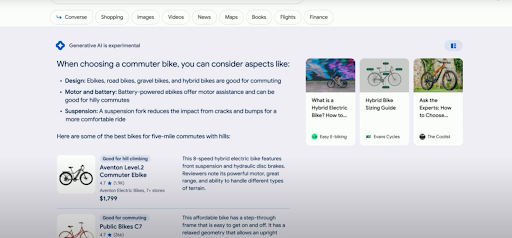Google’s Search Generative Experience Announcement
Last week, Google held its annual developer conference, Google I/O, and we got a glimpse into the newest plans for an ever-evolving Search landscape with the introduction of Search Generative AI.
Google’s been using AI technology behind the scenes in search for years, e.g, RankBrain, Natural Language Processing models such as BERT and MUM, Image/Video/Voice Search, to name a few. Now, we’re being introduced to an updated large language model called PaLM 2, new ways to find useful content and generative AI being featured at the forefront of the SERPs.
Google’s constant mission over the years has been to find ways to improve user experience, which we can see reflected in the countless algorithm updates tailored towards UX, so it would make sense that the SERP gets an experience-inspired revamp!
Main changes we can expect
AI Integrations:

First up, we have AI-powered snapshots powered by LLMs including PaLM 2 and advanced MUM. These panels will be shown at the top of the SERP, only for relevant queries, and Google has described them as a “jumping off-point”, so that users can then interact conversationally with the result and explore the topic further. The AI snapshot was shown to include an overview, pros and cons as well as additional information/links to respective organic sources.
In Cathy Edward’s IO talk, she gives the example of searching for a new bike using the query, “good bike for a 5 mile commute with hills”. The AI powered snapshot intuitively returns important considerations to make when buying a new bike, followed by products alongside their description, reviews, current price, images and USP which is informed by the Google Shopping Graph over Search.
Just this example alone shows how important it will be to provide as much useful, up to date and relevant information as possible, especially in a competitive eCommerce market. Business owners should look to shift their focus beyond the traditional 10 blue links in the SERP, as CTR would naturally be impacted by this change e.g category pages could see a decrease in CTR, but product pages could see a rise if hosted in the AI panel.
These snapshots will also mean a new aspect is added to local search, as options and context will be provided and comparisons can take place between results.
Perspectives:
Another new feature will be the Perspectives filter. These will be focusing on pulling multimedia results such as videos and images which have been posted in places such as Q&A boards or social media, which means a lot more visibility opportunity for content creators. The introduction of this filter just goes to show how visually centred search is becoming! We’ve already discussed how TikTok became a search engine rival and how Instagram is showing personalised content to users to keep up, so it’s natural that Google would be jumping on the same bandwagon to diversify search results. A lot more weight is being placed on visual results, especially with the evolution of image AI, it’s easier than ever to produce images.
Using upcoming updates to the Helpful Content ranking system, Google is making improvements into finding “hidden gems” online, using the system to fine tune expert content and display it in Search as well as demoting unhelpful content.
Alongside this, reviews will hold more weight as Google strives to pull search results “based on first hand experience”, quality and originality which means content that showcases topical authority will be key.
What does this mean for SEO?
Although the changing SERP landscape can seem to be overwhelming, it really is just an evolution of the key aspects of search we already consider. User experience and relevance will still be the driving force behind SEO, but now we just have to think bigger and adapt with AI. The updates Google is making to their LLM’s means that queries and content are being understood at greater depths in terms of intent and context, which opens up a whole new, exciting, side to search!
Some of the biggest takeaways, in terms of actioning SEO from now on:
1. E-E-A-T is more important now than ever.
We need to be producing content which demonstrates this at its forefront, alongside topical authority and focusing on user intent for targeted queries.
Long tail queries will play a much bigger role as users begin to target AI with more conversational questions varying in intent, and keyword research will need to pivot to reflect this; Google’s LLMs are intelligent enough now to take language understanding to a new level.
This can be paired with the fact that Google’s snapshots will be citing its credible resources to enhance its own trustworthiness, which is even more of an incentive.
2. Outside-the-SERP-thinking
We’re straying further and further away from aiming to secure those 10 blue links in favour of position 0 in SERPS. In order to achieve visibility in the Generative AI space, businesses should look to adapt their online strategies to the new developments.
3. Collaboration
Similarly to the last point, collaboration across teams will be key to gaining visibility and SERP real estate (coined by Luminr).
4. Creativity
Tying in with outside-the-box-thinking, and with the leaps and bounds that AI is taking, we have a lot more room to add creativity to our work! Finding ways to use AI to assist with mundane, repetitive tasks leaves space for SEOs to focus on the bigger picture. We can also use emerging AI tools to help speed up processes and evolve with SEO.
For any further information, you can speak to our exerts at any time (or check out Google’s Overview of SGE).


